Reviews & Articles
Migration Season 移民季節
John BATTEN
at 0:00am on 19th August 2015
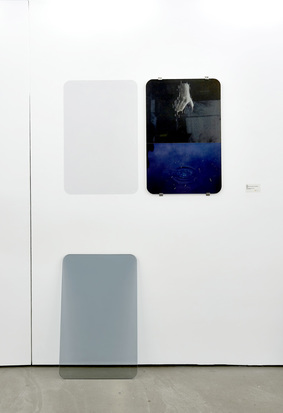
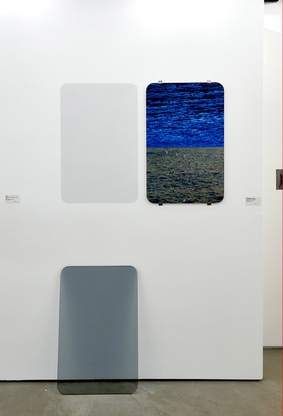
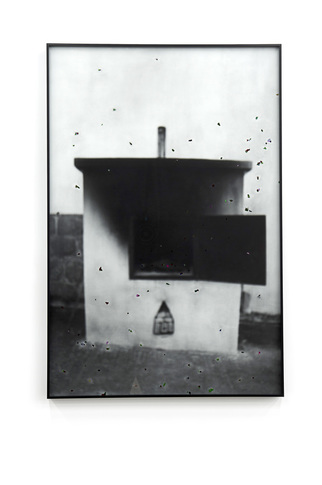
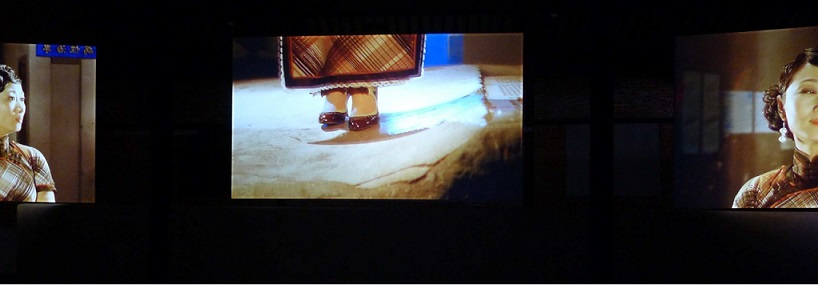
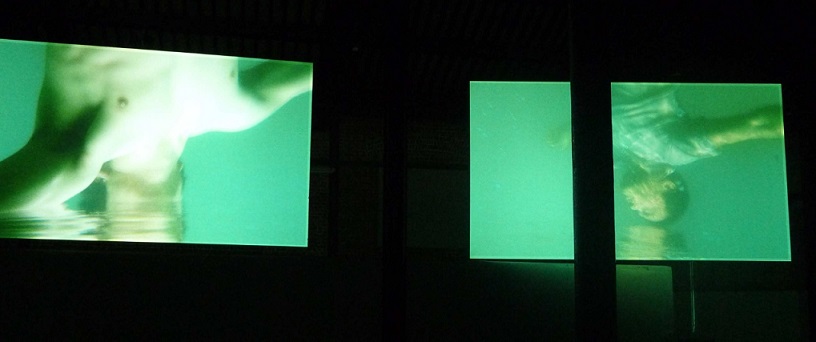
Captions:
1. Elva Lai, She dropped his door keys into a river from a bridge nearby 告別, 2015, inkjet print on matt paper, glass, blue glass, h. 77 x w.50cm. Photograph: Elva Lai.
2. Elva Lai, From a Coastal City to Another Coastal City 由一個海邊城市到另一個海邊城市, 2015, inkjet print on matt paper, glass, paint on wall, blue glass, h. 77 x w. 50cm. Photograph: Elva Lai.
3. Elva Lai, Memory Space (Furnace) 記憶的空間(化寶爐), 2015, charcoal, coloured aluminium paper and inkjet print on archival paper, h. 90 x w.60cm. Photograph: Elva Lai.
4-5. Still images from Isaac Julien's Ten Thousand Waves, 3-channel video version, 2010 (collection of M+, Hong Kong). All photographs by John Batten.
(中文版請往下看 Please scroll down to read the Chinese version.)
Coinciding together in April 2015 were Elva Lai’s solo exhibition at Artify Gallery; Moving Images, a large M+ organised international exhibition; and, a series of Hong Kong International Film Festival movies - each focused on Chinese migration.
Screened at the Film Festival was the film version of Timothy Mo’s Sour Sweet, whose book is one of the best depictions of the Hong Kong immigrant experience. A newly married Hong Kong couple moves to London from their New Territories village in the 1960s, and quickly adapt to living in Britain. However, this hard-working couple fails to decisively deal with the consequences of an unpaid gambling debt to thuggish triad enforcers from London’s Chinatown. Rather than taking a ‘modern’ approach to the problem (dealing directly with the debt, visiting the police), the couple individually and inadequately resort to ‘old-style’ Hong Kong social avoidance and tradition – leading to a violent outcome. In contrast, a younger sister, seemingly immature and naïve, embraces London’s opportunities and soon sees great success.
In a fascinating selection of videos and films, the Moving Images exhibition by M+ depicts a range of emotions around immigration by artists from around the world. Chinese immigration has been widespread for centuries and has seen generally successful assimilation with local cultures (as in Thailand, Indonesia and Philippines), and as an often temporary or dislocated experience, as in the USA and Australia, that had, until the 1970s, strict, predominantly “whites-only” immigration laws.
Elva Lai uses her own migration from the mainland to Hong Kong to poignantly map a multi-layered story in her Sorry, it’s fragile, a photography and mixed-media exhibition. Lai’s father leaves the mainland first, arriving in Hong Kong in the 1970s. The rest of the family is eventually reunited in 1997 after many years living apart, meeting only at brief get-togethers at festival times - a familiar story for many Hong Kong families.
Lai weaves a historic tone into her exhibition by firstly depicting images of the Tung Wah Coffin Home in Pofkulam. Since the 1860s, Tung Wah has provided a unique burial service for China’s far-flung Diaspora: if a person died while overseas, Tung Wah would, if requested, arrange the return of their bones for burial in their home village in China. It was a service provided for thousands of emigrants until quite recently.
Within this historic backdrop, the death of Lai’s father is remembered. Her distraught mother, grieving and upset, threw all physical reminders of her father away: gone were clothes, photographs, and personal objects. Lai best captures the distress of losing her father and of these physical memories in a set of three works (see above), each framed as a view looking out from the old KCRC train’s rectangular windows. Seen from the train are views of the sea, firstly from the mainland and then as the train approaches her new ‘home’, from the Hong Kong seashore.
It is into this same sea that her frustrated mother threw her father’s keys after his death. Locked pain. The pain of not knowing; not knowing (any)more about your father. It is raw and tender, fragile, to remember a missed father. It pricks like a rose thorn and Lai literally covers her photographs with these prickly symbols of grief.
British artist Isaac Julien’s fifty-minute three-channel Ten Thousand Waves in Moving Images is similarly multi-layered. Little Flower, a prostitute, walks the streets of colonial Shanghai alongside trams and coolies, while the sea goddess Mazu (below, played by actress Maggie Cheung Man-yuk) floats above the same streets. A series of scenes builds stories of travel and estrangement across generations, history, places and characters.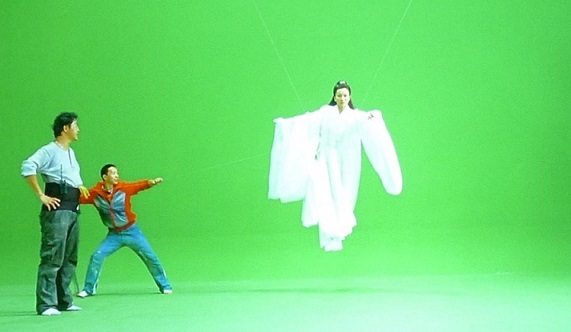
Still image from Isaac Julien's Ten Thousand Waves, 3-channel video version, 2010 (collection of M+, Hong Kong). Photograph by John Batten.
Then, in a terrifying denouement, a lament for lost souls is recited while the surging, cold swell of an in-coming sea-tide covers Morecombe Bay in northwest England. Stranded on sand bars are immigrant Chinese cockleshell pickers – twenty men die in this 2004 tragedy. The ‘live’ infrared black-and-white film footage of a sole survivor waving and shivering for help is juxtaposed with a floating Mazu overhead - and drowned, floating corpses below.
Isaac Julien sees death far from home. Timothy Mo envisages distant hope, success, trust, and failure. Elva Lai remembers loss in Hong Kong. There is requiem in all their stories.
Exhibitions:
'Elva Lai: Sorry, it’s fragile' @ Artify Gallery, Chai Wan
'M+: Moving Images' @ Midtown Pop, Causeway Bay & Cattle Depot, To Kwa Wan
A version of this review was originally published in South China Morning Post, 14 April 2015.
Chinese translation: Elva Lai
〈移民季節〉
約翰百德
適逢四月份在本地畫廊Artify Gallery舉行的年輕藝術家賴明珠個展及由M+舉辦的一系列展覽及活動都以移民成為主題。
在香港國際電影節中播放由海外華人作家毛翔青著作《酸甜》改編的電影,最能概括出香港獨特的移民經驗。故事發生在六十年代,一對香港新婚情侶決定由新界圍村移民到英國倫敦,並很快地適應異國生活。可惜,這對勤奮工作的年輕夫婦因未能支付巨額賭債而受到當地華人社區黑社會的追捕。二人沒有採取“現代的”方式(報警)去解決問題,而是以“舊有的”香港社會的傳統形式去解決,結果造成毀滅性後果。相反,看似較年輕及天真的妹妹,卻擁抱倫敦給予她的機會,帶來未來的成功。
由《M+:流動的影像》展覽及放影選取的一系列錄影作品或電影,塑造出世界各地藝術家與移民議題有關的情態。中國移民史已有世紀之長,並成功地消溶於不同地方的文化之中(例如泰國、印尼及菲律賓),以及暫時性移居經驗在美國或澳洲等發達地區都很常見,而直至七十年代,這種暫時性移居的生活經驗以"白人"為主。
賴明珠在其個人攝影及裝置展覽《抱歉,非常易碎》以個人經驗為背景,由內地移居到香港的深刻回憶鋪設多個層次的內容。她的父親首先在七十年代由內地移民香港,其家人經歷漫長的分離後逐漸地在香港九七回歸後團聚-這故事常見於香港大部份家庭。
賴明珠的作品交織著香港歷史,首先以香港薄扶林東華三院義莊拍攝到的影像開始。早於八十年代,東華三院義莊提供一項專為海外華人提供的服務-若有華人死於海外,東華可以安排先人埋葬於其在中國的故鄉。東華三院義莊已為以千計的華人服務,直至近年才停止。
在歷史背景的陳述之中,她為她父親的死作了紀念。她那悲慟的母親丟掉了有關父親的所有物品去忘記及否定死亡:衣服、照片、個人物品。賴氏最出色的一系列作品以舊式九廣東鐵車廂四方形窗子捕捉失去父親的具體記憶。由這些四方形玻璃窗子,我們看見兩片海,一片海是來自中國大陸的,另一片海是海港的港灣。在這一片海,她喪偶的母親拋下了丈夫遺下的鎖鑰。這鎖住了的悲痛。痛苦來自於不知道,再也不知道有關父親的事物。這是一種原始的、溫柔的、脆弱的方式去紀念一個逝去的父親。這一種痛有如玫瑰的刺,賴氏的作品以這種刺痛覆蓋所有的作品。
在《M+:流動的影像》展覽中,英國藝術家Issac Julien的三屏錄影作品《萬重浪》也是如此豐富的層次。小花、妓女、走在殖民地時期的上海大街上,海神媽祖(由影星張曼玉飾演)飄浮在同一街道上。一系地場景塑造出旅客的故事,以及不同年代、地方、角色之間的隔阂。
然後,在悲慘的結局中,一首哀嘆亡靈的哀歌在英國西北的莫克姆灣冰冷的潮水中吟誦。擱淺在沙灣的是來自中國的移民拾具勞工-在二零零四年的慘劇中一共有二十個死者。一個人飾演幸存者的黑白片段並置在飄浮在海之上的海神媽祖,海中浮沉著溺斃的屍首。
Issac Julien 在遠處看見死亡,毛翔青探索遠方的希望、成就、信任及失敗。賴明珠的作品紀錄香港的失去。安魂曲在他們的作品中奏起。
展覽:
賴明珠「抱歉,非常易碎」@灣仔Artify Gallery
「M+:流動的影像」@ 土瓜灣「牛棚藝術村」及銅鑼灣Midtown POP
原文刊於《南華早報》,2015年4月14日
